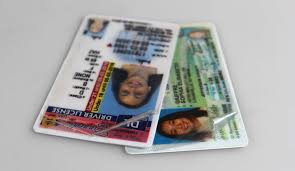Products Description
A Comprehensive Guide to Scannable IDs
In today’s digital age, scannable IDs have become an integral part of every industry, combining security, convenience and efficiency. From age verification in retail and alcohol sales to access control in corporate environments and events, scannable IDs simplify procedures that used to require manual verification. As these ID technologies continue to advance, it is critical for businesses and organizations to understand their capabilities, benefits and applications. ideverest is a leader in identity solutions, providing high-quality scannable IDs that meet the diverse needs of modern industries. This guide will fully explore the basics of scannable IDs, including how they work, types, benefits and industry applications.
What are scannable IDs?
A scannable ID card is an ID that contains a barcode, magnetic stripe, QR code or RFID chip that can be read by a scanner or digital device. These ID cards are designed to quickly and securely store and transmit data, allowing for instant verification of an individual’s identity, age, access rights or membership status. The data stored on a scannable ID card can be read by a variety of devices, including barcode scanners, magnetic stripe readers and mobile phones with the appropriate software.

Main components of a scannable ID:
Barcode/QR code:
Barcodes and QR codes are machine-readable representations of data. Barcodes typically contain information such as an ID number, while QR codes can hold more complex data such as URLs, contact details, and authentication information.
Magnetic stripe:
The magnetic stripe is often found on the back of many traditional ID cards and is used to encode data that can be read by a card reader. This technology is widely used in credit cards, loyalty cards, and hotel room cards.
RFID/NFC chip:
Radio frequency identification (RFID) and near field communication (NFC) chips enable wireless data transfer between an ID and a reading device. This technology is widely used in contactless payment systems, access control, and inventory management.
Embedded security features:
Scannable IDs often have additional security features such as holograms, watermarks, and microtext to prevent counterfeiting and ensure authenticity.
Types of scannable IDs
Scannable IDs come in a variety of forms, each suitable for different use cases. Understanding the various types of scannable IDs can help organizations choose the solution that best meets their needs.
Driver's license: In many countries, driver's licenses often have a barcode or magnetic stripe that stores personal information, including name, address, date of birth, and license type. Scanning these IDs can quickly verify a person's identity and age, which is particularly important in retail environments where age-restricted products such as alcohol and tobacco are sold.
2. Employee ID cards: Employee ID cards are often equipped with RFID or NFC chips to enable contactless access to secure areas of the workplace. These cards can be programmed to give different employees specific access rights to ensure that only authorized people can enter specific areas.
Student ID cards: Many educational institutions use scannable student ID cards for a variety of purposes, such as library borrowing, meal service, and attendance records. These student cards are often equipped with a barcode or QR code that can be linked to the student's profile in the institution's database.
Membership cards: Membership cards for gyms, clubs, and other institutions are often equipped with barcodes or magnetic stripes to record membership information, such as name, membership level, and expiration date. Scanning these cards can quickly complete check-in and access to exclusive facilities.
5. Event Ticketing and Badges:
Scannable IDs are widely used at events and conferences, where attendees receive badges with QR or barcodes. These badges can be used for entry, session recording, and social networking. This technology simplifies the check-in process and provides important data about attendee behavior.
Benefits of Scannable IDs
The use of scannable IDs brings many advantages to various industries, resulting in enhanced security, increased efficiency, and improved customer experience.
1. Speed and Convenience:
Scannable IDs enable quick and smooth verification of information, thereby reducing wait times and improving the overall efficiency of processes such as registration, access control, and sales transactions.
2. Improved Security:
Scannable IDs are not easily copied or forged due to security features such as holograms, microtext, and encrypted data. These features make them an important means of preventing unauthorized entry and ensuring that only legitimate personnel can enter secure areas or events.
3. Data Accuracy:
By eliminating the need to manually enter data, scan ID technology reduces the risk of human error and ensures that the information stored and retrieved is accurate and up-to-date. This is particularly important in fields that require data precision, such as healthcare and finance.
Versatility:
Scannable IDs have applications in many areas, including access control, attendance records, loyalty programs, and inventory management. Due to their versatility, these tools are extremely valuable to all types of businesses and organizations.
Cost-effectiveness:
Implementing scannable IDs can lead to long-term savings by streamlining operational processes, reducing administrative costs, and reducing reliance on physical security personnel.
How to Choose the Right Scannable ID
When choosing the right scannable ID solution, you need to consider your organization's specific needs and requirements. Here are some factors to consider:
Application:
Identify the primary purpose of the scannable ID. For example, if the ID is primarily used for access control, then an RFID or NFC chip may be the best choice. If the ID is primarily used for retail transactions, then a barcode or magnetic stripe may be more appropriate.
Security Requirements:
Consider the level of security required. In high-security environments, ID cards with advanced features, such as encrypted RFID chips, holographic images, or biometrics, may be required.
Compatibility:
Make sure the scannable ID you choose matches your existing infrastructure, such as scanners, readers, and software systems. This is critical for smooth integration and operation.
Durability:
Scannable IDs should be durable enough to withstand daily use in the deployment environment. For example, IDs used in industrial environments may need to be rugged and wear-resistant.
Customization:
Consider whether you need to customize the ID with branding, unique designs, or specific data fields. Such customization can enhance the functionality and appearance of the ID, making it more practical and professional.
Industry Trends: The Future of Scannable IDs
The scannable ID industry is continuing to evolve, driven by technological advances and changing consumer needs. Here are some trends in the future of scannable IDs:
1. Biometric Integration:
It is becoming more common to integrate biometric data, such as fingerprint or facial recognition, into scannable ID documents. This provides an extra layer of security, ensuring that only the legitimate owner can use the ID.
2. Mobile Wallets and Digital IDs:
With the popularity of smartphones, digital IDs stored in mobile wallets are becoming popular. These digital IDs can be scanned like physical cards, providing the same security and convenience as physical cards without the need to carry a physical card.
3. Blockchain for increased security:
Blockchain technology is being investigated as a way to increase the security of scannable IDs. By storing ID data in a decentralized blockchain, organizations can effectively prevent unauthorized access and ensure that data cannot be tampered with.
Conclusion: IDeverest’s commitment to quality and innovation.
Scannable IDs are an essential tool for businesses and organizations today, providing secure, efficient and versatile solutions for a variety of applications. Whether used for access control, age verification or event management, scanning IDs brings many benefits such as increased security, accuracy and convenience.
IDeverest’s commitment to quality and innovation ensures that its scannable ID solutions meet the highest standards of performance and reliability. By leading the industry and continuously improving its products, IDeverest provides identification solutions that help businesses operate more efficiently and securely in an increasingly digital environment. Whether you want to implement scannable IDs for employees, members or customers, IDeverest has the expertise and technology needed to achieve excellent results.
Tags:
You like

Fake Social Security Number Ca

Fake Social Security Card

Fake SSN

SSN Card

